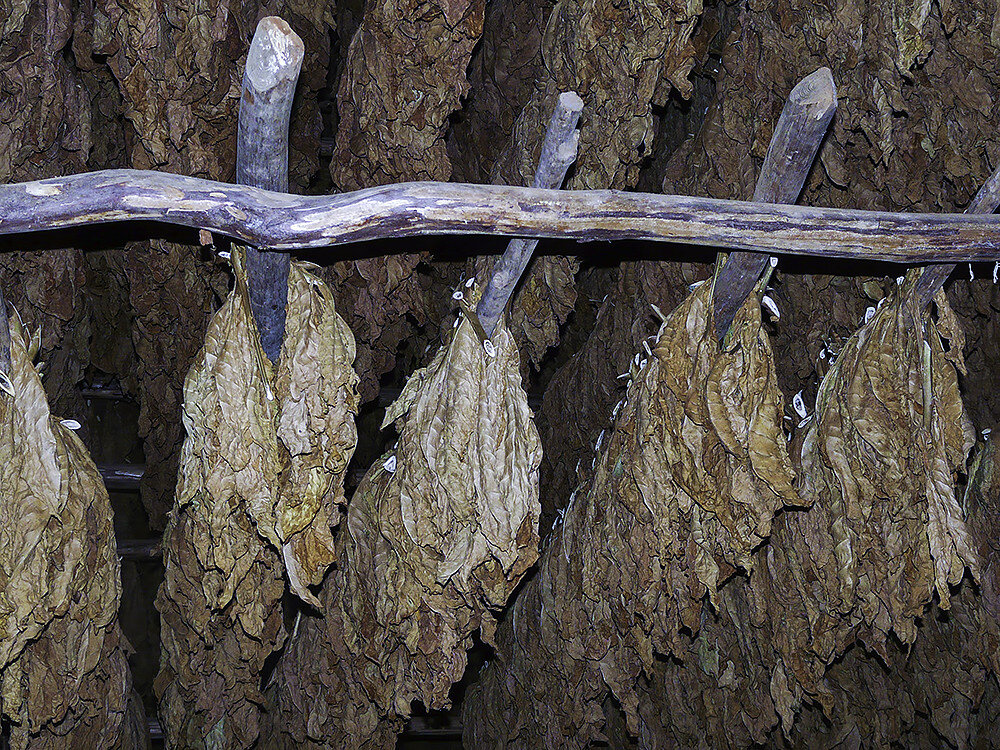Source Story: Smokehouse Blend
Smokehouse Blend cladding & flooring pays homage to the historic barns used for decades to cure tobacco.
Air-cured tobacco drying in an old barn (Photo Source: Flickr)
Tobacco field (Photo Source: Flickr)
Smokehouse Blend with Oil Finish
Old tobacco barn in the Midwest, USA (Photo Source: Flickr)
Tobacco curing on rafters, or “tiers” in a tobacco barn (Photo source: Flickr)
Tobacco Barn (Photo source: Flickr)
Growing Gold: An Era of Tobacco Farming in the Eastern US
Stepping into an old tobacco barn, you enter into another age. Smoke still clings to the blackened walls and the air tastes sweet and musty. Looking up, there are aged wooden poles stretched out horizontally, stacking all the way up to the tall ceiling. You can imagine whole families crammed in the space in the humid mid-summer heat, hoisting plants up into the rafters during the tobacco harvest. Drying leaves would turn from fresh green to warm yellow and finally, to a golden brown, symbolizing the cash crop’s economic significance in the region’s history.
In North Carolina alone, there are estimates of over 50,000 tobacco barns still standing. Most of these barns, located in New England and Appalachia, were tall, in order to stack rows of curing tobacco vertically, and measured generally 20 ft x 20 ft. Usually built of pine, these barns were constructed of hewn-log with mortar or sawn timber reinforced with tin.
Tobacco barns were built with vents specifically designed for climate control. The humidity and temperature "recipe" over curing time would contribute to the eventual flavor of the tobacco.
Flu and Air-Cured Tobacco Curing Methods
Flu-cured barns were common in North Carolina, and involved a brick or stone furnaces that were fed pine logs to create smoke. Fire was always a risk with this process, so barns were intentionally built far apart and close to roads in order to minimize the risk of spreading fire.
Smoke and heat would distribute amongst the hanging tobacco, drawing out moisture, but preventing it from becoming too dry and brittle. Huge shutters operated by pulleys would help regulate the temperature and humidity, depending on weather and smoke. Each farmer would have their own prized “recipe” for curing, or “cooking off” the the moisture. During the three stages of curing, temperatures in the barns would rise from 120 degrees F to 135 and 160 degrees and then finish at 180 degrees over a span of around 6 days.
Unlike the flu-cured tobacco barns, air-cured barns were constructed to have open ventilation for a longer drying process of about eight weeks. The resulting cured tobacco was lower in sugar, giving the tobacco a light, sweet flavor with a high nicotine content.
Smokehouse Blend Softwood Cladding & Flooring
Our Smokehouse Blend honors these historic barns. A mix of mostly pine, spruce, and cedar from the eastern US, this softwood blend showcases the saw-trace marks and distressed aged patina of this post-industrial reclaimed wood. You’ll see oxide stains, fastener holes, and knots, giving this FSC Certified Recycled wood plenty of rustic character. Best used for interior cladding, our Smokehouse Blend can also work as light-use flooring, tabletops, and custom applications.
Contact us for more information, and to find ways to integrate this Smokehouse Blend into your next project!
Smokehouse Blend







